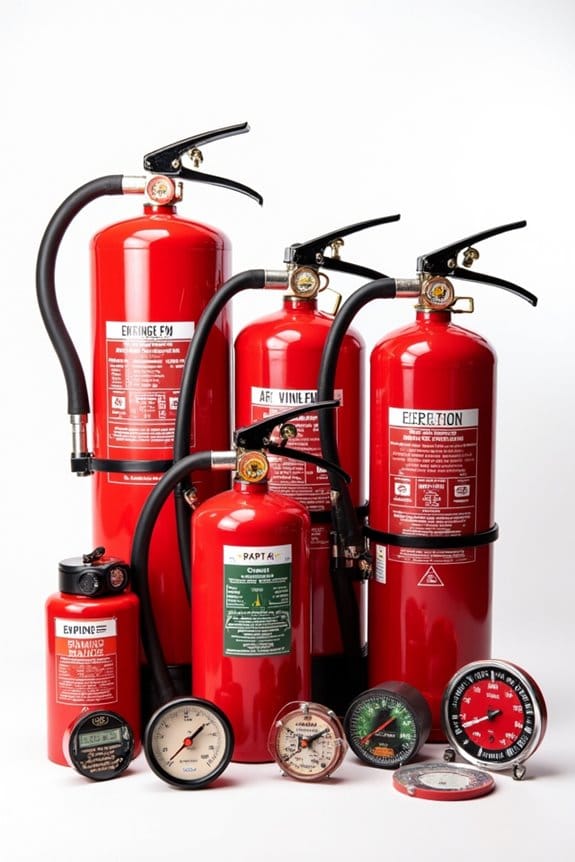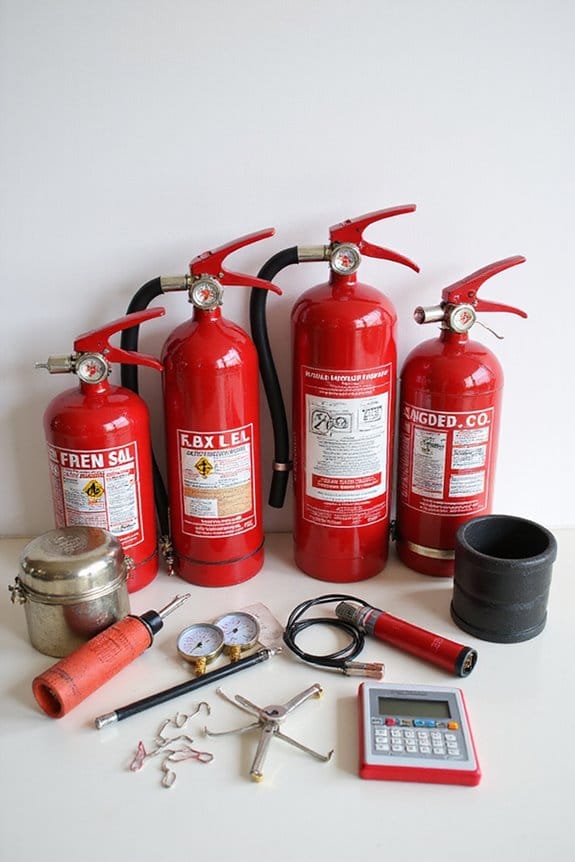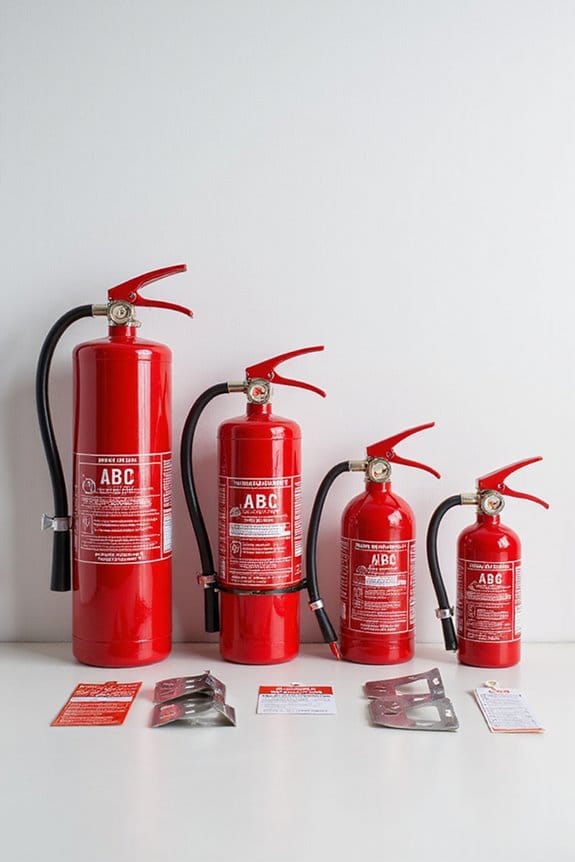Absolutely, fire extinguishers can expire! Typically, their lifespan hovers around 10 to 12 years. Here’s a quick rundown: 1) Check the manufacture date, and replace if it’s over 12 years old. 2) Rechargeable models need recharging every 6 years. 3) Regular maintenance is essential to guarantee they’re effective. If you use an expired extinguisher, it could fail when you need it most. So, let’s keep you safe—stick around to learn how to spot signs for replacement!
Key Takeaways
- Fire extinguishers typically have a lifespan of 10 to 12 years, after which they should be replaced.
- Rechargeable extinguishers need recharging every 6 years to ensure effectiveness.
- Hydrostatic testing is required every 5 to 12 years to maintain canister integrity.
- Expired extinguishers may fail during emergencies, increasing safety risks.
- Regular maintenance and inspections are essential to ensure extinguishers remain functional and compliant.
Understanding Fire Extinguisher Lifespan
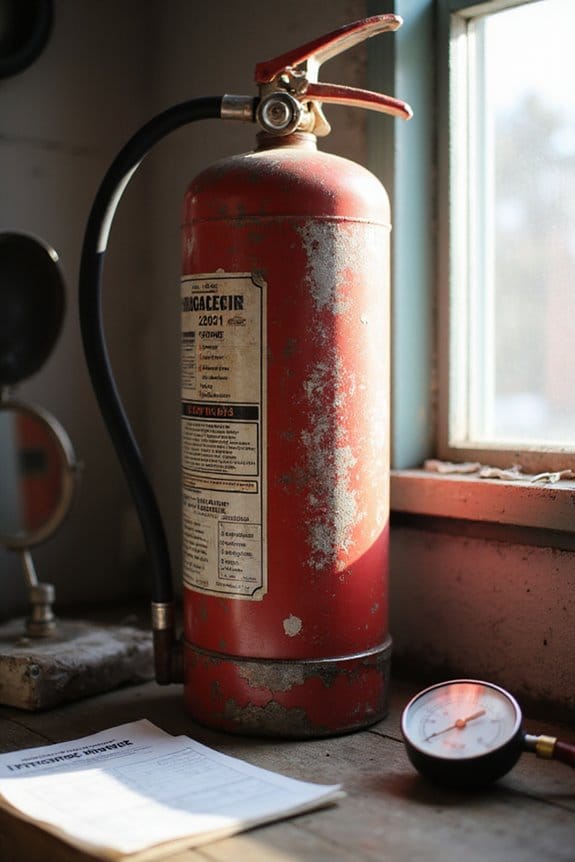
When it comes to understanding fire extinguisher lifespan, it’s important to realize that these life-saving devices don’t last forever. Generally, they have a lifespan of 10 to 12 years. Here’s what you need to know for fire safety and emergency preparedness:
- Manufacture Date: Check the stamped date on your extinguisher. If it’s over 12 years old, replace it.
- Maintenance Matters: Rechargeable extinguishers need recharging every 6 years. Don’t skip this!
- Hydrostatic Testing: This is vital every 5 to 12 years to guarantee canister integrity.
Types of Fire Extinguishers and Their Lifespan
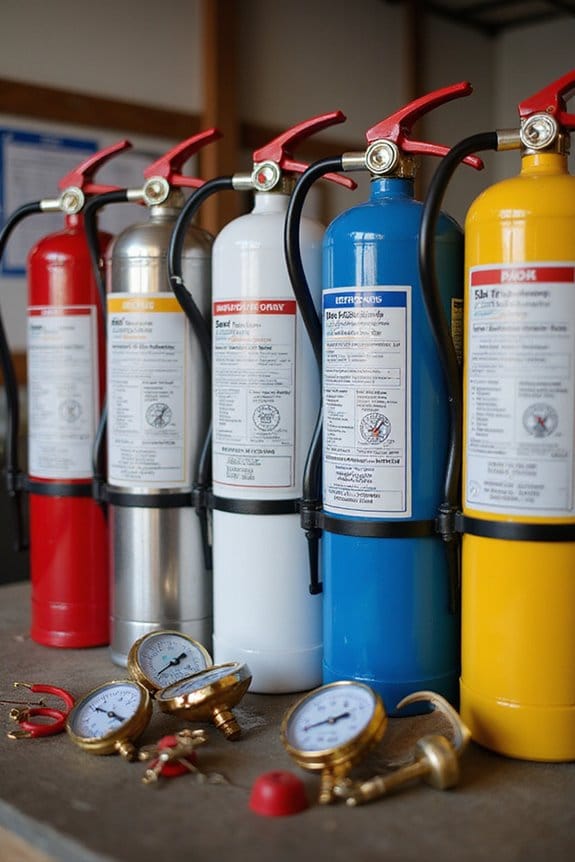
Fire extinguishers are essential tools in our quest for safety, but not all of them are created equal. Here’s a quick look at some fire extinguisher types and their lifespan variation:
- Water Extinguishers: Best for Class A fires, with a lifespan of 5 to 15 years, but avoid electrical fires!
- Foam Extinguishers: Great for Class A and B fires, lasting about 10 to 15 years. Just don’t use them on electrical fires!
- Dry Powder Extinguishers: Versatile for Classes A, B, and C, with a lifespan of 5 to 15 years. They’re your go-to for electrical fires.
- CO2 Extinguishers: Perfect for electrical and Class B fires, lasting up to 15 years.
- Wet Chemical Extinguishers: Tailored for Class F fires, with a lifespan of 6 to 12 years. Ideal for kitchens!
Identifying Manufacture and Expiration Dates
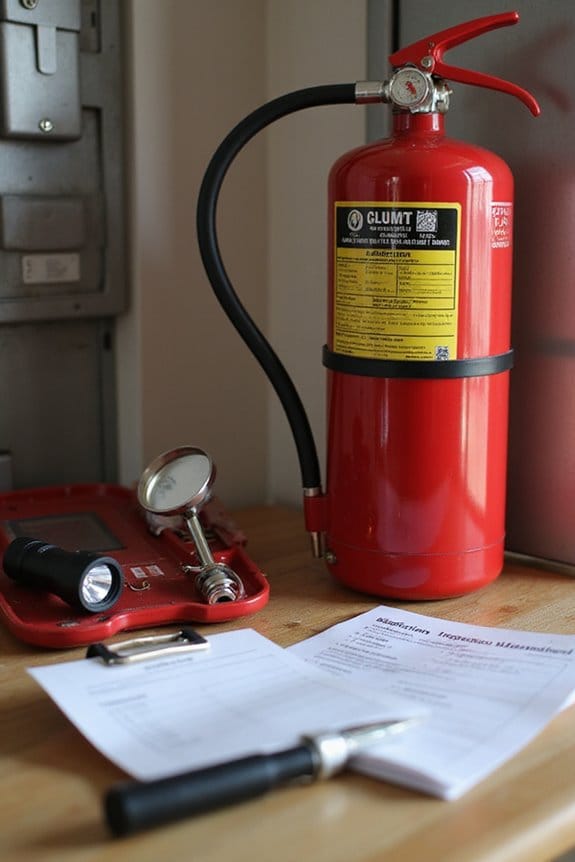
Knowing the types of fire extinguishers and their lifespans is only part of the equation for ensuring our safety. Here’s how to identify those vital manufacture and expiration dates:
- Check the Cylinder: The manufacture date is often stamped on the body or printed on the label. Sometimes, it’s hidden under plastic rings. A little cleaning might help!
- Look for Inspection Labels: These often include important dates, such as the last service or inspection.
- Understand Dating Codes: Some manufacturers use specific codes that might require a quick call to customer service for clarification.
- Watch for Lifespan: Remember, traditional extinguishers last about 10-12 years, while disposables should be replaced every 10 years.
Keeping track of these details can really save us in an emergency!
Regulatory and Safety Standards
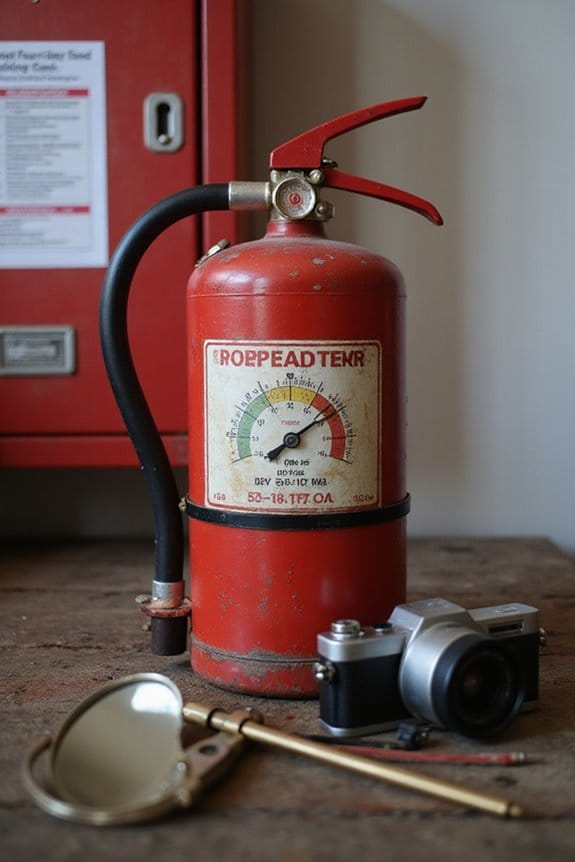
While guaranteeing we’re equipped with the right fire extinguishers is essential, understanding the regulatory and safety standards that govern them is just as important. Here’s what you should know:
- Lifespan: Disposable extinguishers need replacing every 12 years, while rechargeable ones must be recharged every 6 years.
- NFPA Standards: The National Fire Protection Association (NFPA) 10 sets guidelines for maintaining fire safety and operational readiness.
- Obsolescence: Some models become obsolete and should be removed from service.
- OSHA Compliance: Employers must document inspections and maintenance. Keeping proper records is vital for compliance.
Staying updated on these regulatory updates not only guarantees safety but also protects you from potential liabilities. After all, no one wants a fire extinguisher that’s more of a decorative piece than a lifesaver!
Maintenance and Servicing Requirements
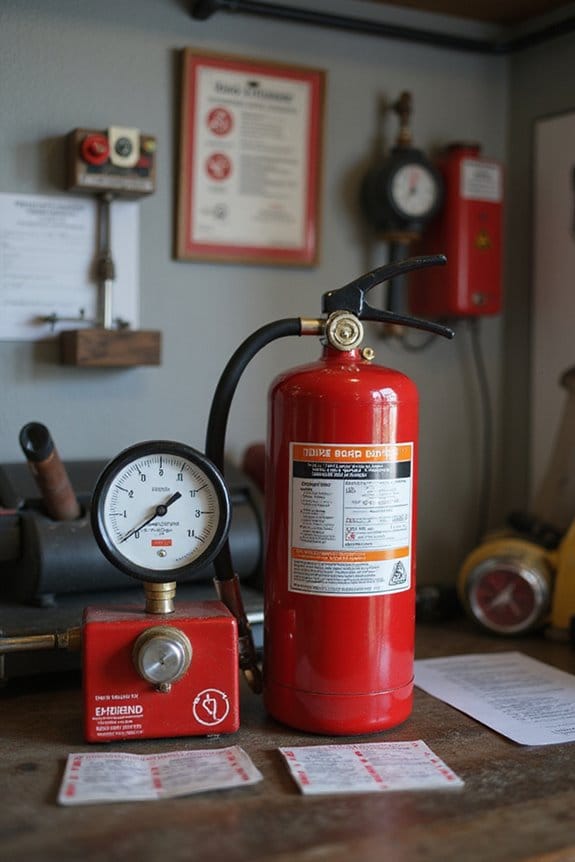
When it comes to keeping your fire extinguishers in top shape, regular maintenance is key to ensuring they work when you need them most. Here’s what I recommend:
- Annual Maintenance: Have a trained technician conduct a thorough check at least once a year. They’ll examine all mechanical parts and the extinguishing agent.
- Six-Year Cycle: If you’ve got stored pressure extinguishers, they need internal inspections every six years. This involves emptying them and checking for leaks.
- Twelve-Year Testing: Don’t forget the hydrostatic pressure testing every twelve years! It’s essential for safety.
Consequences of Expired Fire Extinguishers
Expired fire extinguishers can be more than just a nuisance; they can pose serious risks when you need them most. Here are some consequences I think you should know about:
- Failure to Operate: Expired extinguishers might not work at all, leaving you defenseless against a fire.
- Decreased Effectiveness: The agents inside can go bad, meaning they won’t control different fire types properly.
- Increased Danger: Using an expired extinguisher could force you dangerously close to flames, risking burns or smoke inhalation.
- Financial Liabilities: If an expired extinguisher fails during an emergency, you could face costly lawsuits and higher insurance premiums.
Signs Your Fire Extinguisher Needs Replacement
You might not think about it often, but keeping an eye on your fire extinguisher is just as important as checking your smoke alarms. Here are some signs it might need replacement:
- Visual Inspections: Look for dents, cracks, or rust. Any physical damage can weaken its performance.
- Pressure Checks: Verify the gauge is in the green zone. If it’s not, it could mean trouble.
- Missing Tags: If the inspection tag is outdated or missing, that’s a red flag.
- Hose and Nozzle: Check for blockages or damage. A damaged hose won’t do you any good.
- Previous Use: If it’s been used, get it professionally recharged or consider replacing it.
Stay safe—don’t wait until it’s too late!
Proper Storage and Handling of Fire Extinguishers
Taking care of your fire extinguisher doesn’t stop at checking for signs of replacement; proper storage and handling play a big role in guaranteeing it’s ready when you need it most. Here are some tips to keep in mind:
- Mounting Techniques: Use appropriate brackets to secure your extinguisher upright and in visible spots, ideally along exit routes.
- Environmental Considerations: Store extinguishers in moderate temperatures—between 40°F and 120°F. Avoid extreme heat or cold, and keep them out of direct sunlight.
- Accessibility: Make sure extinguishers are easily reachable, not blocked by furniture, and clearly marked.
Ensuring Compliance With Fire Safety Regulations
While it might seem like just another item on your safety checklist, ensuring compliance with fire safety regulations is essential for protecting lives and property. Here’s how to stay on track:
- Regular Inspections: Monthly visual checks and annual maintenance are important. Don’t skip these!
- Fire Safety Audits: Conduct audits using compliance checklists to confirm everything’s in order.
- Document Everything: Keep records of inspections, maintenance, and replacements. This isn’t just busywork; it’s necessary for compliance.
- Stay Updated: Replace extinguishers every 12 years and recharge them every six years if they’re rechargeable.
Frequently Asked Questions
Can I Refill a Disposable Fire Extinguisher Myself?
Think of a disposable fire extinguisher as a one-time hero; I wouldn’t attempt the refill process myself. Safety concerns loom large, and professionals guarantee it’s done right, keeping us all safe from potential disasters.
What Should I Do if My Extinguisher Is Leaking?
If I notice a leaking extinguisher, I immediately remove it from service and follow emergency response procedures. I’ll check the causes of the leak and contact a professional for assessment and safe handling.
Are There Fire Extinguishers Specifically for Kitchen Use?
Imagine a vigilant knight guarding a kitchen castle. Kitchen extinguishers are those brave defenders, essential for fire safety, especially against grease fires. I always keep one nearby, knowing it’s my kitchen’s best ally in emergencies.
How Do I Properly Dispose of an Expired Fire Extinguisher?
When disposing of an expired fire extinguisher, I always check local regulations. I prefer recycling options that guarantee safe handling, avoiding any hazards while protecting the environment. It’s essential to follow guidelines for safe disposal.
Can Fire Extinguishers Be Used on Any Type of Fire?
Picture a raging inferno; not all extinguishers can tame it. Each fire type needs specific extinguisher ratings. I’ve learned to match the right one, or risk turning a small blaze into a disaster.

